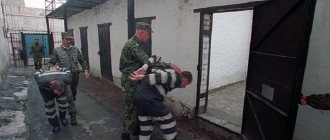What are the types of colonies and who is sent to them?
According to Art. 74 of the Criminal Executive Code of the Russian Federation, adult convicts serve sentences of imprisonment in colonies. These institutions are divided into settlement colonies, general, strict and special regime correctional colonies. The type of correctional colony in which the convicted person must serve his sentence is determined by the court.
Article on the topic “There are more decent people than in the wild.” Report from the colony of Kokorin and Mamaev The colony-settlements contain prisoners convicted of intentional crimes of minor and medium gravity and crimes committed through negligence. Also, positive convicts from a general or strict regime colony can be transferred there. In settlement colonies, convicts are kept without guards, but under the supervision of the administration. They can move freely around the colony during the hours from waking up to bedtime, and with the permission of the administration of the institution, they can travel outside its boundaries. Prisoners are allowed to wear civilian clothes, they can carry money with them and use it without restrictions. Convicts, as a rule, live in dormitories specially designed for them; they may be allowed to live with their families both on the territory of the colony and outside it.
In general regime colonies, first-time convicted citizens who have committed a serious crime, as well as careless or intentional crimes of minor or moderate gravity, serve their sentences, unless the court sends them to a settlement colony.
Maximum security correctional colonies house men who have been convicted for the first time of committing particularly serious crimes. Male recidivists who have previously served imprisonment are also placed there.
Men who have had a particularly dangerous relapse into crime, as well as those sentenced to life imprisonment, serve their sentences in special regime colonies.
In correctional colonies of general, strict and special regime, there are three types of conditions for serving a sentence: ordinary, light and strict. In normal and light conditions, convicts live in dormitories, in strict conditions - in locked rooms. Prisoners serving life sentences are kept only in cells, usually of no more than two people. Depending on the type of colony and conditions of detention, convicts have the right to a varying number of visits with loved ones, telephone calls, parcels and parcels.
Women in the Russian Federation can serve their sentences in general regime colonies, as well as in settlement colonies.
Minors or convicts left there until they reach the age of 19 serve their sentences in educational colonies. Also, in such colonies there may be isolated areas that function as general regime correctional colonies; they contain prisoners who turned 18 years old while serving their sentences.
Types of penal institutions in the Russian Federation
Prison-type establishments
Prison-type institutions can be designed differently, and the list of restricted freedoms and the permissible period of isolation may vary, based on this, different institutions of the penitentiary system are distinguished.
- The temporary detention center is part of the police departments and does not even belong to the penal system, since it is intended primarily to restrict the freedom of movement of persons convicted of minor offenses and undergoing an identification procedure.
- Rehabilitation colonies for minors are distinguished by the most comfortable conditions for prisoners living in barracks-type dormitories, and therefore not subject to classification as prisons.
- Medical and correctional institutions are intended for those inmates who cannot be cured by therapeutic methods in an isolation ward, prison or colony, due to the complexity of the disease or its potential threat to others. Despite the presence of locked cells and the lack of the possibility of free movement around the territory, it is possible to classify such institutions as prisons with greater assumption, since the subsidized food and conditions created for rehabilitation are not comparable to a traditional prison.
- Military units intended for disciplinary action on military personnel are also not a prison, as they provide for accommodation in barracks and the possibility of labor and public service. Isolated premises in disciplinary units (punishment cells) are used only for persistent offenders.
- Colonial settlements provide the inmate with sufficient freedom of movement and ways of spending time, which he can spend on work or social life. It is incorrect to call such units of the penitentiary system prisons, since even the very concept of isolated confinement in cells is not applicable to settlements that limit the inmate only to the freedom to leave the prescribed place of residence and employment.
- Arrest houses , which are only planned to be built in Russia, are a prison in its purest form and are designed to have a harsh impact on the psyche of the convicted person as a result of a short stay in almost complete isolation from the outside world and under conditions of total restriction of freedoms.
Correctional colonies
Correctional colonies have differentiated conditions of detention, in particular:
- under general and strict regimes, inmates live in barracks equipped with premises for common living, and the differences are expressed in the degree of restriction of freedoms and the list of benefits provided;
- the special regime can be equated to a prison, since most of the prisoners in such institutions are kept in cells in conditions comparable to a pre-trial detention center or a detention center.
Knowing about the regimes of imprisonment in men's and women's prisons in Russia, it is worth learning about the terms of detention.
How is a prison different from a colony?
In colloquial Russian speech, the word "prison" is often used to refer to any institution in which convicted persons serve a sentence of imprisonment. However, according to the Criminal Executive Code (EC) of the Russian Federation, a prison is a separate type of correctional institution.
Article on the topic
When going to a pre-trial detention center is salvation. How HIV infection is treated in Moscow prisons Those who have been sentenced to imprisonment for a term of over five years for committing especially serious crimes, as well as for certain crimes such as terrorism, hostage-taking, organizing an illegal armed group, hijacking are placed in prisons. plane, train or watercraft, seizure of power. Prisons also house particularly dangerous repeat offenders and those who were transferred from correctional colonies for malicious violation of the order of serving their sentences.
Prisoners are kept in locked general cells and, in special cases, in solitary confinement. As a rule, a prison is a separate building or a complex of buildings, while a colony occupies a large area with industrial premises and a residential area; on the territory of the colony there may be a store, a club, a library, a school and even a football field.
Moscow Sretenskaya Theological Academy
Deacon Nikita Kuleshov 03/19/201911355
In the Russian Federation, the process of reforming the penal system is underway, new programs are being developed, various bills are being considered, including with the participation of the Orthodox Church.
This determines the need to study the historical experience of the formation of the penal department and its correctional functions, as well as the activities of the Church, its participation in the lives of prisoners, the cooperation of the Church in the past and the prospects for the development of relations in the present time. This article opens a series of materials that represents an attempt to analyze the development of the relationship between the church and the Russian penitentiary system in the context of the history of our Fatherland.
Content:
- What is prison and the penitentiary system?
- The first mentions of imprisonment in history
- Official recognition of the prison in the Code of Laws of Ivan the Terrible
- Prisons during the time of Peter I
- Prison life
What is prison and the penitentiary system?
Modern problems in the functioning of the penitentiary system have deep historical roots. Imprisonment in the Russian state appeared quite early. In Ancient Rus', imprisonment was carried out by placing the guilty person in an ice hole or by imprisoning him in iron shackles. And this punishment had a warning value. For the formation of the penitentiary system, as well as for the development of criminal law, the code of law of 1497 was important, in which, in fact, all the legal acts that existed before in Rus' were combined.
For the first time at the legislative level, imprisonment was a new type of punishment for criminal offenses under Ivan the Terrible; confirmation of this can be seen in his code of law of 1550. It is from this moment that the formation of the penitentiary system, which has a continuous character, should be counted.
The penitentiary in Rome was the name given to the spiritual court where various cases of absolution were considered.
But in order to move on to a consistent study of the penitentiary system, it is necessary to understand what a prison is and what the essence of punishment in the form of deprivation or restriction of freedom is in the opinion of legal scholars of the 18th - 19th centuries.
Criminal law textbooks give different concepts of what the essence of this punishment is, but all such statements can be reduced to the following definition: “In placing a person within the walls of a prison building with or without compulsion to work: in limiting his freedom by he is prohibited from leaving a certain place, city or village, or he is expelled from some place with a prohibition for him to return to it”[1]. This thesis was proposed by the outstanding legal scholar Professor P. D. Kalmykov.
Places of detention and the law throughout their history stick together because the former protect the latter, making the law not a dead letter, because this is the problem of humanity, that the laws “that govern human societies, although derived from their nature, require for their implementation consciousness, and therefore can be violated”[2]. But paradoxically, it is the prison that can become, and sometimes does become in many cases, a school of immorality. Restriction of freedom is an equal punishment for all people, for human freedom is an invaluable benefit. A prison can become edifying and corrective for a person, but only if “it is organized according to strictly reasonable rules, for it has a close internal analogy with many crimes resulting from the abuse of free will” [3].
One cannot ignore the name “penitentiary system”. The penitentiary in Rome was the name given to the spiritual court where various cases of absolution were considered. The translation of the Latin word poenitentia means “repentance.”
After a brief historical review, it will become absolutely clear that on the part of the state, the penitentiary system does not at all lead a person to the most important thing - to repentance, which in turn means “change”, but it is a punitive system that does not spare, does not correct, but destroys and distorts a person .
The first mentions of imprisonment in history
It is worth considering the earliest historical references, which in one way or another suggested some kind of conclusion. The charter of Yaroslav the Wise prescribes placement in a “church house” for certain actions of a moral nature. Only after payment of a fine in favor of the bishop did this imprisonment end.
During the era of Ivan the Terrible, there was a sharp rise in forced tonsure as monks, as well as exile of persons unfavorable to the state, including hierarchs
It is difficult to say exactly how this kind of imprisonment took place, in what conditions, where these houses were located, since there is no reliable information, but there is an assumption: “Staying in a church or episcopal house did not have any relation to repentance”[4].
This is inherently strange considering the place the person was going to. There is an example that, at first glance, can challenge the statement of N.S. Suvorov. To do this, you should turn to the Nikon Chronicle, it contains a story about the robber Mogut, who repented after being tried under Prince Vladimir. One should pay attention to the request of this robber to send him to the episcopal house for repentance[5], but here “the very image of the repentant robber is common in Christian legends, which had the gospel robber as their prototype”[6].
An important aspect for the further development of punishments and imprisonments in Rus' was the frequent replacement of the death penalty with lifelong imprisonment in a monastery for repentance, followed by tonsure. This was possible due to the “sadness of the clergy”[7]. We can conclude: already by the 14th century. there was a kind of penitentiary system - forced tonsure as a monk, otherwise a person would face physical violence. This type of punishment was applied to political opponents and to punish clergy. But gradually this system of punishment takes on other forms, and there is an excessive increase in control on the part of the secular authorities, which cannot but affect the activities of the monastic exile.
Official recognition of the prison in the Code of Laws of Ivan the Terrible
Next, it is necessary to mention the moment when, at the legislative level, imprisonment becomes an official punishment. This happens in 1550, when Ivan the Terrible introduces a new type of punishment for criminal offenses - imprisonment. The Code of Law speaks about this. Similar punishments are prescribed from 6 to 12, 33, 42, 47, 52-56, 67 rules.
The process of imprisonment itself took place approximately as follows: “Execute with a trade execution, beat with a whip, and throw into prison” [8]. Under Ivan the Terrible, there were three types of imprisonment: lifelong; to the decree of the tsar himself on release: “Throw him into prison before the tsar’s sovereign decree” [9], and the latter - bail was expected, according to a court verdict.
People often fled to monasteries on their own, because if they put on a cassock, this would end the persecution for the crime
From the very inception of the penitentiary system, the beginning of rudeness and cruelty towards prisoners began.
On the part of the state, “neither clothing nor food was provided to the convicts. They were supplied as best they could by their relatives, and the homeless, shackled in twos, went one by one, with guards, to the markets and courtyards for alms, and were content with it.”[10] During the era of Ivan the Terrible, there was a sharp rise in forced monastic tonsure, as well as the exile of persons unfavorable to the state, including hierarchs. One such example is Metropolitan Philip, deprived of his rank and imprisoned in a monastery in 1568.
Until 1649, the established punishment system did not undergo any changes, however, during the reign of Alexei Mikhailovich, some innovations took place. But the Council Code also contains provisions on punishments, which only by the 19th century would be recognized by many jurists as ineffective in correcting prisoners. For crimes, cutting off a hand, an ear, and similar tortures, including the death penalty, were prescribed. According to the compilers, this type of punishment had an edifying meaning for all people: “Despite that, it was not common for others to do this”[11].
In addition to introducing various types of punishment, the Council Code also prescribed: “a) to build prisons at the expense of cities and counties; b) elect watchmen from among “good people”; c) bailiffs receive salaries from the “meager order”; d) give “feeding” to the convicts of the “black hut”; e) give dead convicts to relatives for burial, and bury those without relatives “at the state cost”; f) for the escape of convicts to recover from the bailiffs; g) provincial elders to monitor the convicts and the buildings in which they were housed”[12]. But it is difficult to say whether this instruction was observed.
A certain period of imprisonment of a person was established: from one day to four years or for an indefinite period. But, in addition to everything else, physical work was added: “Put him in prison for four years, and take him out of prison to send him to all sorts of sovereign products, that’s why in the kaydal” (Article 10, Chapter 21) [13]. This type of imprisonment has survived to this day; only the form of enforcement of this order for prisoners has changed - from unbearably cruel to softer and more acceptable.
The problem of keeping prisoners, based on the text of the Code of Laws, should have been solved in the following way: the so-called “sovereign salary”, or “feed money”[14], but despite the innovations, the most acceptable practice for the state was preserved, when the prisoner supports himself by asking for alms[15].
The limited capacity of prisons, the lack of proper maintenance, and the poor condition of the premises served as a reason for the fact that the term of imprisonment was not long. The convicts themselves were housed according to the type of crime in general prisons and in earthen pits during solitary confinement.
Prisons during the time of Peter I
For the analysis of the further development of the penitentiary system and criminal law, the Military Article of 1715 is noteworthy[16]. Despite the fact that this document has many purely military rules, it should still be noted: it contains mainly rules of criminal law. In relation to criminal law, it is noteworthy that there are trends towards establishing a causal relationship between an action and a criminal result. This follows directly from the text of the Article and contributes to the development of criminal law and the rethinking of punishment.
According to the Article, the following types of punishment were established: the death penalty, in turn, was divided into simple, i.e. shooting, hanging, etc., and qualified, i.e. quartering, wheeling, etc. Corporal punishment was also divided into simply painful and self-mutilating; there was also immediate and indefinite exile. During the time of Peter I, the labor of prisoners in a variety of types of work acquired a wide scope: “Peter I quickly appreciated the advantages of prison labor, which did not require large financial costs, and began to actively use it to implement his grandiose plans in the process of carrying out state reforms”[17]. There was also hard labor (for galleys, construction of harbors, fortresses, factories), confiscation and fines.
Overcrowding entailed the most dangerous consequences: epidemic diseases, which often threatened to spread among the local population
At the same time, of course, the peace of the peaceful monasteries could not but be disturbed because of the exiles.
People themselves often fled to monasteries, because if they put on a cassock, this would end the persecution for the crime. The exception was treason against the sovereign. But if we look in more detail at the structure of monastery prisons, one can be horrified by the conditions in which the prisoners were kept there: a hole was dug in the ground, the edges of which were lined with bricks, which, in turn, were covered with boards. Such a phenomenon as rats attacking a prisoner was the norm: “There were cases when rats ate the nose and ears of criminals sitting in an underground prison. Giving them anything to protect themselves from these small predators was strictly prohibited.”[18] The monastery prison also existed to “maintain the discipline of the clergy”[19]. Of course, the study of monastic prisons, their structure, the maintenance of prisoners, etc. receives a lot of attention in historical science, but several important aspects should be highlighted. For example, not all places of confinement in monastic prisons were distinguished by the same attitude towards prisoners that was described above.
For example, the Suzdal Spaso-Evfimiev Monastery, which since 1766 had been a place of exile and imprisonment, had special instructions for dealing with convicts: “Keep these insane people in two or three empty chambers set aside from the archimandrite, but not shackled, and have such supervision over them.” so that they, through their madness, cannot cause any harm to themselves and others... so don’t let them write. If any of them began to act extravagantly, then in that case, put that one in peace, without giving him food for a while; and once he is pacified, then you can bring him together as before with others. Those who are meek and do not do extravagance are allowed into church to listen to Divine singing, but under the supervision of guards; What does it have to do with keeping an eye on them so that they don’t engage in obscene conversations with those staying there, and they also don’t leave the monastery. The guards should interact with them as much as possible without using severity”[20]. Based on the content of this instruction, we can conclude: there was also an alternative detention of prisoners in monastery prisons.
In pre-Petrine times, the right to exile to monastic prisons belonged not only to the Tsar or the Patriarch, but also to the bishops. Since the middle of the 19th century, exile to a monastery prison was possible only by the highest order.
Prison life
Where, if not in prison life, is the state’s real concern for the life of a person who has crossed the line of the law reflected, because it is from there that the moral correction of the prisoner begins. The Tsarist prison, as well as the penitentiary system of the entire 20th century, in this sense is not the best example of concern for the moral correction of the prisoner. On the contrary, based on all available information, we can say with confidence that the state, instead of correcting prisoners, for hundreds of years cultivated an entire intra-prison world, with its own hierarchy, its own special laws and concepts about morality and life in general.
Is it necessary for a modern clergyman who is preparing to visit or is already visiting prisoners to know about this hierarchy, about the fundamental laws on which this world is based? There is no doubt that knowledge is extremely necessary in such institutions.
Before giving an example of an unspoken hierarchy among prisoners, it is necessary to examine the reasons why the prison world arose. An analysis of the report of the Main Prison Directorate (GTU) shows the following: there was an acute problem of prison overcrowding. Let's take the time from June 16, 1880 to January 1, 1882. During the specified period of time, the overcrowding of prisons amounted to 24%, which essentially excludes “the maintenance of any satisfactory order for the detention of prisoners”[21]. Such overcrowding entailed the most dangerous consequences: epidemic diseases, which, in turn, take the lives of not only prisoners, but often “threaten to spread them among the local population”[22]. Of course, we are not talking about quality medical care in such a situation. In this regard, important evidence is the denunciation to the State Technical University by the Minsk vice-governor about the situation of one of the prisons: “The prison, built for forty places, sometimes accommodates up to 260 people... Nothing guarantees that epidemic diseases can appear every minute and be expressed in a more acute form”[ 23].
As an example of medical care, we can cite the following episode from the life of one prisoner who wrote a complaint addressed to the Minister of Justice: “He was transferred to a hospital, where at that time a typhoid patient was lying, not isolated from others. During our stay in the hospital, despite all the precautions, lice appeared in our underwear, and at night we did not sleep for a long time due to the mass of bedbugs infesting the bed... Upon verification of Krapp's complaint, its validity is recognized and attention is drawn to the administration's disdainful attitude towards restoring order in the specified prison"[24].
Of course, the above described was an acute problem, but there was another one that aggravated the deplorable situation - the unsatisfactory condition of prison buildings and premises and the conditions of detention of prisoners. A clear example: “the cells are so damp that upon entering, despite the open windows, it smells of dampness and completely musty air; all the walls are covered with mold, the floor and the eaves above the ceiling have rotted and even collapsed in places; the window bars don’t stay in place, the dampness of the brick and the rottenness make it cold.”[25].
Among other things, in Tsarist Russia measures were used that destroyed human dignity and caused physical suffering: “For exiled convict prisoners, disgraceful signs were installed in the form of two quadrangular flaps, a color different from the clothing itself”[26]. They could also shave either the right or left sides of the head, which was also a distinctive sign. The hearts of the prisoners were also hardened by the arbitrariness of the prison administration itself, which established any punishment for those who violated the intra-prison regime. This could have been beating with rods, and shackling, etc. But in prison relations, over time, something emerged that, sometimes in its cruelty, could not be compared with the arbitrariness of the administration - this is “fist law among the convicts themselves, based on a tough and clear hierarchy in the criminal world"[27].
Gradually, as already noted, a clear hierarchy is emerging among the prisoners themselves. The life described above is definitely a living hell for a person who has committed a minor crime. Once inside the walls of the prison, he will be called a “lumber,” but such people were clearly divided into two categories: those who, upon release, will no longer commit the crimes of “lumbers,” and those who, while serving their sentence, under the influence of the appropriate environment , becomes the one who will commit a crime again and again, because it will already be part of his life - “span timber”.
As M. G. Detkov points out, “the beams were fun and a reason for constant bullying for the “lucky guys,” who were divided into three classes: “zhigans” - gamblers and tramps, “punks” - thieves, and “lucky ones” - swindlers and cheaters”[28]. Each class was divided into different types[29].
Physical strength played a decisive role, the nature of the crime, friendship with celebrities of the prison world, risky playing cards, etc. served as auxiliary factors. They developed their own kind of prison code of life.
All of the above conditions do not in any way affect the correction of the prisoner, but, on the contrary, root him in evil. For many, prison can become a school of immorality. And for some of the prisoners, the prison world became a substitute for the world from which they were thrown out for breaking the law.
Deacon Nikita Kuleshov
Keywords:
state, prison, history, Code of Law, punishment, prisoner, monastery, hierarchy of prisoners
[1] Kalmykov P. D.
Textbook of criminal law. ― St. Petersburg: Printing house of the Public Benefit Partnership, 1866. ― P. 262.
[2] Lokhvitsky A.
Criminal law course. - St. Petersburg: Printing house of the Government Senate, 1867. - P. 15.
[3] Ibid. P. 264.
[4] Suvorov N. S.
Textbook of Church Law. - M.: A. A. Kartsev, 1912. - P. 212.
[5] Kostomarov N. I.
Split. - M., 2012. - P. 305.
[6] Ibid. P. 304.
[7] Vladimirsky-Budanov M. F.
. Review of the history of Russian law. - Kyiv, 1907. - P. 359.
[8] Russian legislation of the X-XX centuries: (Texts and comments). In 9 volumes / Under general. ed. O. I. Chistyakova. ― M. Legal literature. T. 2. Legislation of the period of formation and strengthening of the Russian centralized state (XIV-XVI centuries). - P. 519.
[9] Ibid.
[10] Nikitin V. N.
Prison and exile 1560 – 1880 Historical, legislative, administrative and everyday situation of prisoners, transit prisoners, their children and those released from custody, from the time of the emergence of the Russian prison to the present day. - St. Petersburg: 1880. - P. 127.
[11] Tikhomirov M. N., Epifanov P. P.
. Cathedral Code of 1649. - M.: Moscow University Publishing House, 1961. - P. 269.
[12] Nikitin V. N.
Prison and exile 1560 – 1880 Historical, legislative, administrative and everyday situation of prisoners, transit prisoners, their children and those released from custody, from the time of the emergence of the Russian prison to the present day. - St. Petersburg: 1880. - P. 6.
[13] Russian legislation of the X-XX centuries: In 9 volumes / Ed. O.I. Chistyakova. - M.: Legal literature, 1985. Acts of Zemsky Sobors. T. 3. - P. 231.
[14] Korablin K.K.
The Russian penitentiary system: the formation and mechanism of functioning of the prison department in the Far East in the second half of the 19th - early 20th centuries. - Nizhny Novgorod, 2001. - P. 48.
[15] Efremova N. N., Isaev I. A., Stamm I. S.
. Development of Russian law in the second half of the 17th-18th centuries. - M.: Nauka, 1992. - P. 89.
[16] Russian legislation of the X-XX centuries: (Texts and comments). In 9 volumes / Under general. ed. O. I. Chistyakova. ― M. Legal literature. T. 4: Legislation during the formation of absolutism. - P. 511.
[17] Korablin K.K.
The Russian penitentiary system: the formation and mechanism of functioning of the prison department in the Far East in the second half of the 19th - early 20th centuries. - Nizhny Novgorod, 2001. - P. 30.
[18] Detkov M. G.
Prisons, camps and colonies of Russia. ― M.: “Verdict-lM”, 1999. ― P. 55.
[19] Shalyapin S. O
. The church-penitentiary system of Russia in the 15th - 18th centuries. - Arkhangelsk: IPC NARFU, 2013. - P. 108.
[20] Prugavin A. S.
Monastic prisons in the fight against sectarianism: Essay / A. S. Prugavin. - 1905. - P. 4.
[21] Struchkov N. A.
Corrective labor law course. Problems of the special part. ― M: Legal Literature, 1985. - P. 65.
[22] Detkov M. G.
Prisons, camps and colonies of Russia. ― M.: “Verdict-lM”, 1999. ― P. 105.
[23] Struchkov N. A
. Corrective labor law course. Problems of the special part. ― M.: Legal Literature, 1985. - P. 55.
[24] Tkachevsky Yu. M.
Soviet correctional labor law. - M.: Moscow University Publishing House, 1971. - P. 47.
[25] Ponomarev P. G.
The effectiveness of legal norms governing the use of basic remedies. - M.: Academy of the Ministry of Internal Affairs of the USSR, 1989. - P. 263.
[26] Detkov M. G.
. Prisons, camps and colonies of Russia. ― M.: “Verdict-lM”, 1999. ― P. 107.
[27] Ibid.
[28] Ibid..
P. 108.
[29] Struchkov N. A.
Criminal liability and its implementation in the fight against crime. ― Saratov: Saratov University Publishing House, 1978. ― P. 55.
What is a pre-trial detention center and who is kept in it?
Pre-trial detention centers (SIZOs) are primarily used to hold suspects and accused persons against whom detention has been applied as a preventive measure. Those. Those who are under investigation and awaiting trial or are on trial are placed in pre-trial detention centers.
Detention centers in some cases also serve as correctional facilities. They contain convicts left there to perform household maintenance work, and convicts who are to be sent to correctional institutions to serve their sentences after the court verdict has entered into legal force. Also, convicts are admitted to pre-trial detention centers during their transfer from one place of serving their sentence to another.
How to behave when detained
On June 3, 2015, an event occurred in my life, the development of which changed my entire understanding of the judicial system in the Russian Federation, about people holding positions in law enforcement agencies, as well as about all our laws and their application to Russian citizens.
All this happened in one of the northern cities. At 19.30, as usual, I had dinner in one of the cafes of our wonderful city. Of the visitors in the establishment, there were only me and a girl; we had a business meeting with her, at which we discussed the upcoming private screening of one of the films that had recently been released in cinemas. I finished my meal and pushed the plate away from me, when suddenly people in masks and several in civilian clothes burst into the cafe, there were about 15 of them in total. They ordered me to raise my hands and indicate whether I had prohibited items on me, a knife, a pistol or anything else. . After that, they handcuffed me and, bowing my head, took me outside. They put me in a car that was unfamiliar to me and drove me to an unknown direction.
In such cases, I recommend not resisting, speaking as politely as possible, and most importantly, don’t panic!
And from that moment all the most “interesting” things in my life began.
What is a temporary detention facility?
The place for pre-trial detention is also the temporary detention center (IVS), previously called the pre-trial detention cell (KPZ). Temporary detention facilities are not part of the structure of the Federal Penitentiary Service, but belong to special institutions of the Ministry of Internal Affairs of the Russian Federation. They are located at the territorial internal affairs bodies or border guard authorities. Temporary detention centers are used for temporary detention of persons detained on suspicion of committing a crime. If the court subsequently decides to choose a preventive measure in the form of detention, the suspects will be transferred to a pre-trial detention center.
Court hearings
I strongly recommend audio and video recording of court hearings, starting from the very first hearing. Unfortunately, in the minutes of the court session, the secretary may not reflect the entire essence of the process and miss something important for you.
Using a personal example, I will say that only video and audio recordings saved me. 30% of what my so-called victim said was simply not included in the protocol, or they were included, but by removing a couple of sentences, they changed the meaning of his words. And only thanks to video recording, he again spoke the truth at the repeated hearings.
Yes, yes, I had repeated hearings scheduled, because after the first interrogations of the victim, based on his testimony, I had to be acquitted. But, as I already indicated above, in our “Democratic” times, this is practically unrealistic. The arbiters decided to send the case for additional investigation and everything started all over again. And by that time I had been kept in custody for more than 9 months.
How to behave in court
As for behavior in court. Here I will say for sure, there is no need to argue with the judge, much less swear. This simply doesn’t make any sense, and the maximum that you will achieve with this is a biased attitude towards yourself, although you will never know about it. It is better to dress neatly and look fresh for the court, despite the fact that you are behind bars and it is not so easy to do there. But the judge’s attitude also depends on this, believe me, he is the same person.
What is a special detention center?
Another penitentiary, i.e. A correctional institution of the Russian Federation, part of the structure of the Ministry of Internal Affairs of the Russian Federation, is a special detention center. It contains persons sentenced to administrative arrest. According to Art. 3.9. Code of Administrative Offenses of the Russian Federation, this type of punishment is prescribed for the most serious offenses (malicious disobedience to a lawful order or requirement of a police officer, petty hooliganism, etc.), if other punishments, such as a fine, are not enough. In Russia, the minimum period of administrative arrest is 12 hours, and the maximum is 30 days.
First interrogation. What you need to know
Personally, I recommend that at the first interrogation or confrontation, use Art. 51 of the Constitution of the Russian Federation. In short, it states that every citizen has the right not to testify against himself, as well as his close relatives. In general, it gives the right to remain silent.
Be sure to check the time at the end of the investigative action - the beginning of the interrogation and the end, as well as the date. Since the interrogation can last from 1 hour to several days. It is important to understand that in the case when you were held for several hours or days during interrogation, this is a gross violation. Therefore, it is necessary that the time is recorded correctly. In cases where the interrogation lasts more than one hour, I suggest not arguing with the people who are doing this, and especially not trying to leave the office on your own, or wherever you are being held there. After the interrogation, you must carefully read the protocol and only then sign it, even if a lawyer is present.
Further development of the Russian penitentiary system
In the process of introducing various legislative reforms, including criminal ones, changes were made to the procedure for keeping criminals in custody. The labor camps that operated during the Soviet period were completely abolished.
Due to the limited space for detention in pre-trial detention centers, some prisons have been temporarily or permanently converted into pre-trial detention centers. At the moment, no modernizations have been made to improve the system of control over the treatment of prisoners in places of deprivation of liberty.
Federal state prison-type institutions
Citizens of Russia can obtain general information about prison-type institutions located within the state. The most famous are the following objects:
| No. 1 Federal Penitentiary Service for the Vladimir Region | ||||
| Index | Address | Modes | Contacts | |
| 600120 | Vladimir region, Petushinsky district, Pokrov, st. October Revolution, 75-A | General Strict | 8 (49243) 6-72-70 | |
| In the Vladimir region (Vladimir Central) | |||
| Index | Address | Mode | Contacts |
| 600020 | Vladimir region, Vladimir, st. Bolshaya Nizhegorodskaya, 67 | General Strict | 8 |
| FKU prison of the Federal Penitentiary Service of Russia in the Krasnoyarsk Territory | ||||
| Index | Address | Mode | Contacts | |
| 662606 | Krasnoyarsk region, Minusinsk, st. Gorky, 114 | General Have a question for a lawyer? Ask now, call and get a free consultation from leading lawyers in your city. We will answer your questions quickly and try to help with your specific case. Telephone in Moscow and the Moscow region: +7 Phone in St. Petersburg and Leningrad region: +7 Free hotline throughout Russia: 8 (800) 301-39-20 Strict | 8 (39132) 2-59-82 | |
| GUFSIN of Russia for the Krasnoyarsk Territory | ||||
| Index | Address | Mode | Contacts | |
| 663180 | Krasnoyarsk region, Yeniseisk, st. Dekabristov, 11 | General Strict | 8 (391-95) 2-46-92 | |
| FKU prison of the Federal Penitentiary Service of Russia in the Saratov region | ||||
| Index | Address | Mode | Contacts | |
| 412315 | Saratov region, Balashov, st. Uralskaya, 17 | General strict | 8 (84545) 6-32-72 | |
| FKU prison of the Federal Penitentiary Service of the Ulyanovsk region | ||||
| Index | Address | Mode | Contacts | |
| 433513 | Ulyanovsk region, Dimitrovgrad, st. Kalugina, 66 | 8 (84235) 9-34-61 | ||
| FKU prison of the Federal Penitentiary Service of Russia in the Chelyabinsk region | |||
| Index | Address | Mode | Contacts |
| 457670 | Chelyabinsk region, Verkhneuralsk, st. Severnaya 1 | General Strict | +7(35143) 2-13-98 +7(3519) 48-84-19 |
| FKU prison 2 Federal Penitentiary Service for the Lipetsk region Yeletskaya Krytka | ||||
| Index | Address | Mode | Contacts | |
| 399783 | Yelets, st. Proletarskaya, 1B | General Strict | +7(47467) 7-18-47 | |










